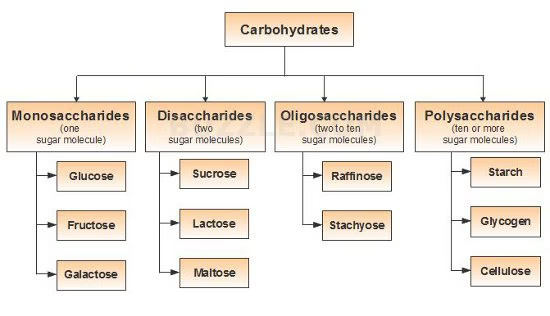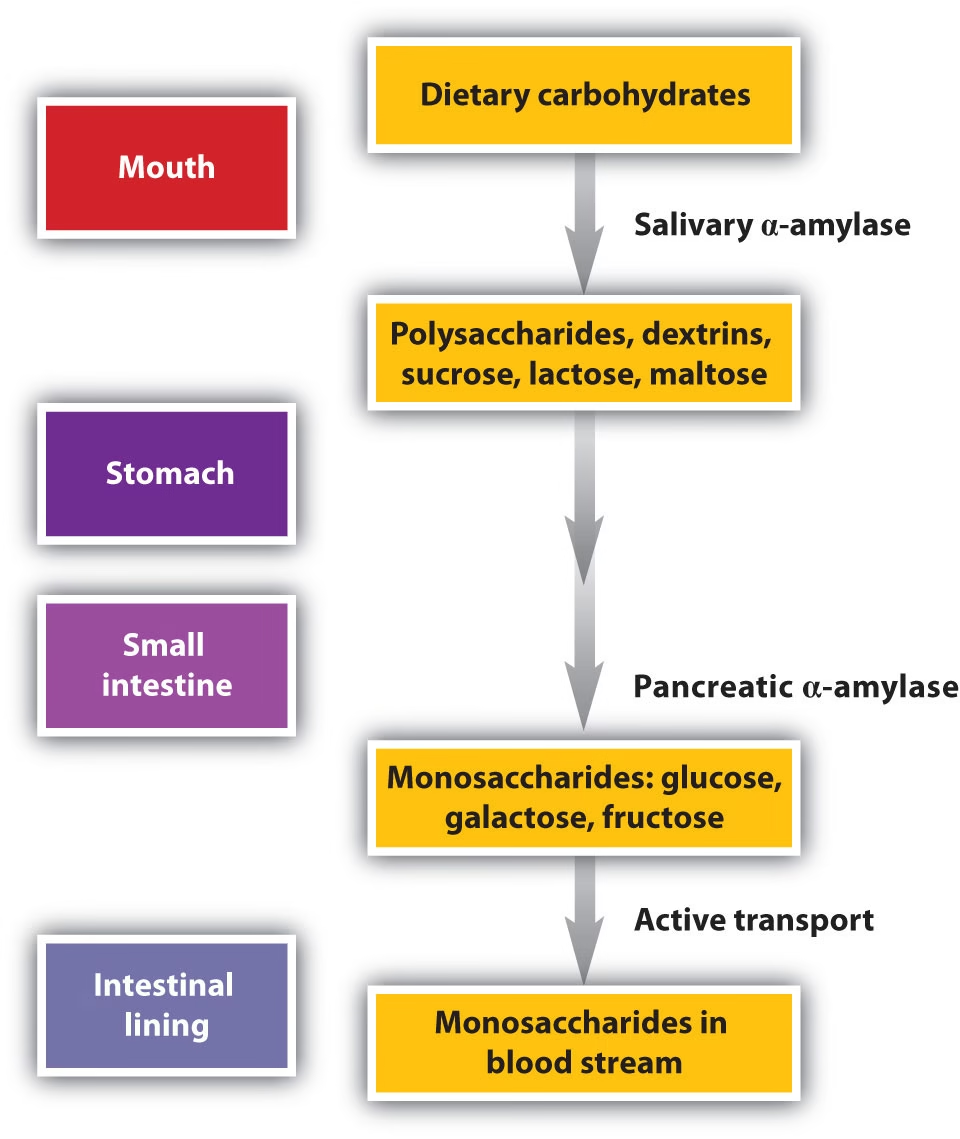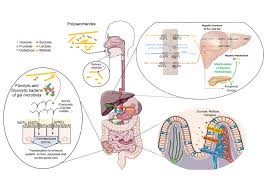
Introduction
-
Carbohydrates are a major dietary energy source and must be broken into simple sugars before absorption.
-
The diet contains starches, disaccharides, and sugars, but only monosaccharides can be taken up by the intestine.
-
Digestion begins in the mouth and is completed in the small intestine through salivary, pancreatic, and brush-border enzymes.
-
These enzymes convert complex carbohydrates into glucose, fructose, and galactose.
-
Absorption occurs through specific transporters on intestinal cells using active and facilitated mechanisms.
-
The efficiency of this process depends on enzyme activity, pancreatic function, and intestinal mucosal health.
-
Any defect in enzymes or transporters leads to carbohydrate malabsorption and related clinical symptoms.
Composition of Dietary Carbohydrates
The carbohydrates consumed in a typical diet belong to different categories:
Polysaccharides
-
Starch (amylose, amylopectin) – major plant carbohydrate
-
Glycogen – animal storage form
-
Dextrins – partially digested starch fragments
Disaccharides
-
Sucrose → Glucose + Fructose
-
Lactose → Glucose + Galactose
-
Maltose → Glucose + Glucose
Monosaccharides
-
Glucose, fructose, galactose – directly absorbable
Non-digestible carbohydrates (Dietary fiber)
-
Cellulose
-
Hemicellulose
-
Pectins
-
Beta-glucans
These fibers contribute to gut health, stool bulk, slower glucose absorption, and a balanced microbiome.
Important Note:
Only monosaccharides are absorbed into the bloodstream; all complex carbohydrates must be broken down.
Digestion of Carbohydrates
Carbohydrate digestion involves three major phases: oral, gastric, and intestinal.
A. Oral Phase: Initial Hydrolysis
1. Enzyme Involved
Salivary α-Amylase (Ptyalin)
-
Secreted by the parotid and submandibular glands.
-
Optimal pH: 6.7–7.0 (neutral).
-
Inactivated when food reaches the acidic environment of the stomach (pH < 4).
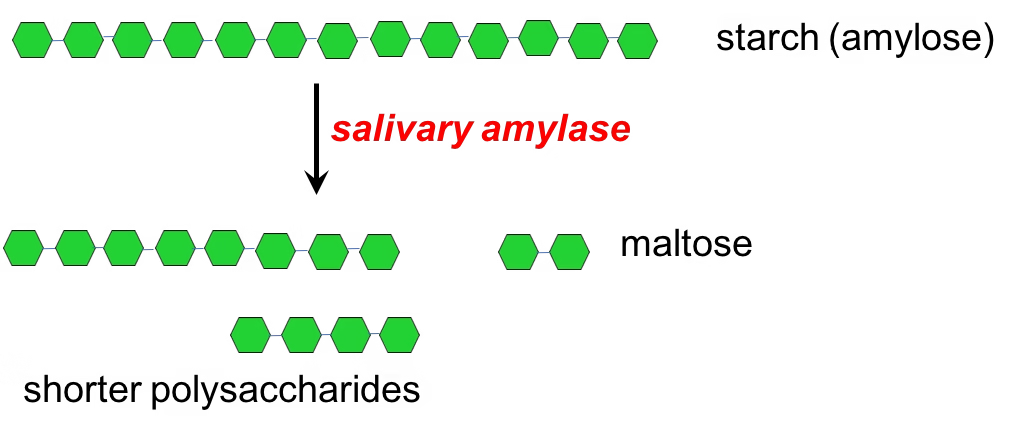
2. Substrate and Action
Acts on Starch (Amylose & Amylopectin)
-
Breaks internal α-1,4-glycosidic bonds in polysaccharides.
-
Does NOT act on:
-
α-1,6 bonds of branch points
-
Cellulose
-
Disaccharides (lactose, sucrose, maltose)
-
3. Products Formed
-
Maltose (disaccharide)
-
Maltotriose (trisaccharide)
-
α-Limit dextrins (small branched fragments)
These products require further digestion by intestinal enzymes.
4. Role of Mechanical Processing
-
Chewing (mastication) increases surface area of food.
-
Mixes amylase with food for efficient hydrolysis.
-
Forms a moist bolus that is easier to swallow.
5. Duration and Importance
-
Digestion in the mouth lasts only a few seconds.
-
Some activity continues briefly in the upper stomach until amylase is inactivated.
-
Although limited, this step primes carbohydrates for rapid digestion in the small intestine.
B. Gastric Phase: Mixing and Acid Inactivation
1. No Carbohydrate-Digesting Enzymes
-
The stomach does not secrete enzymes that hydrolyze carbohydrates.
-
No amylase, sucrase, maltase, or lactase are produced by gastric mucosa.
2. Inactivation of Salivary α-Amylase
-
Food mixed with gastric acid (pH < 4) causes rapid inactivation of salivary α-amylase.
-
Any starch digestion that began in the mouth ends within minutes of entering the stomach.
3. Mechanical Mixing (Churning)
-
Strong peristaltic movements mix food with gastric secretions.
-
Forms chyme, a semi-liquid mixture that enhances later intestinal digestion.
-
Breaks down large food particles, increasing surface area.
4. Controlled Gastric Emptying
-
The stomach regulates the delivery of chyme to the duodenum.
-
Slower emptying allows the small intestine adequate time for enzyme action.
-
Gastric emptying is influenced by:
-
Gastrin
-
CCK
-
Enteric nervous system
-
This regulation prevents overwhelming the small intestine with undigested carbohydrates.
5. Minor Continued Activity
-
Before complete acidification, some residual amylase activity may continue briefly in the upper stomach (fundus).
-
But this contribution is very small.
C. Intestinal Phase: Major Digestion
1. Neutralization of Gastric Chyme
When acidic chyme enters the duodenum:
-
Secretin stimulates the pancreas to release bicarbonate-rich pancreatic juice.
-
Neutral pH (6.8–7.4) is restored → optimal for enzyme function.
-
Protects intestinal mucosa from acid damage.
2. Pancreatic Amylase: Luminal Phase Digestion
Enzyme: Pancreatic α-amylase
Stimulated By:
-
CCK (Cholecystokinin) from intestinal cells
-
Vagal stimulation
Action:
Breaks α-1,4-glycosidic bonds in starch and glycogen.
Products Formed:
-
Maltose
-
Maltotriose
-
α-Limit dextrins
(Same end-products as salivary amylase, but in much larger quantity)
Pancreatic amylase is responsible for 70–80% of all carbohydrate digestion.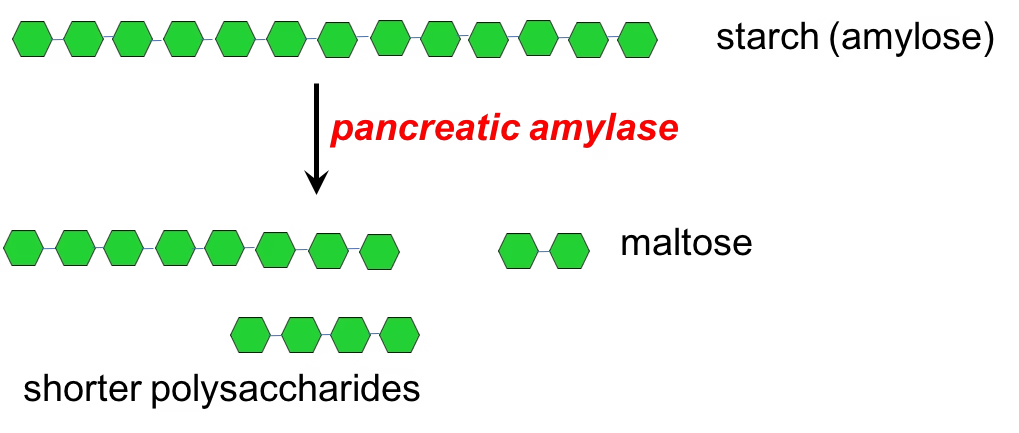
3. Brush-Border Enzymes: Final Hydrolysis
Microvilli of enterocytes contain membrane-bound disaccharidases that complete digestion.
Brush-Border Enzymes
A. Maltase
-
Maltose → Glucose + Glucose
B. Sucrase
-
Sucrose → Glucose + Fructose
C. Lactase
-
Lactose → Glucose + Galactose
-
Most sensitive enzyme; deficiency → lactose intolerance
D. Isomaltase (α-Dextrinase)
-
Breaks α-1,6 bonds in branched dextrins
-
Essential for complete digestion of amylopectin
E. Trehalase
-
Trehalose → Glucose
-
Important for digestion of mushrooms and insects
Importance of Brush-Border Enzymes
-
Without them, disaccharides remain undigested and cause osmotic diarrhea.
-
They determine how efficiently the intestine handles carbohydrate loads.
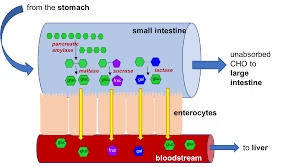
4. Coordination of Digestion and Absorption
As soon as monosaccharides are formed:
-
They are immediately absorbed by enterocyte transporters (SGLT-1, GLUT-5).
-
This prevents carbohydrate accumulation in the lumen.
-
Helps maintain osmotic balance and efficient nutrient uptake.
5. Hormonal and Neural Regulation
-
CCK: stimulates pancreatic amylase secretion.
-
Secretin: releases bicarbonate to optimize pH.
-
Enteric nervous system: regulates motility and mixing.
These mechanisms ensure that digestion is synchronized with gastric emptying.
Absorption of Carbohydrates
1. Site of Absorption
Carbohydrate absorption occurs in:
-
Duodenum and Jejunum – primary sites
-
Ileum – minimal absorption
-
Colon – absorbs only fermentation products like short-chain fatty acids, not carbohydrates
The small intestine contains millions of villi and microvilli, creating a vast surface area that maximizes absorption efficiency.
2. Forms of Carbohydrates Absorbed
Only three monosaccharides are absorbed:
-
Glucose
-
Galactose
-
Fructose
Disaccharides (lactose, maltose, sucrose) and polysaccharides (starch, glycogen) must be digested before absorption.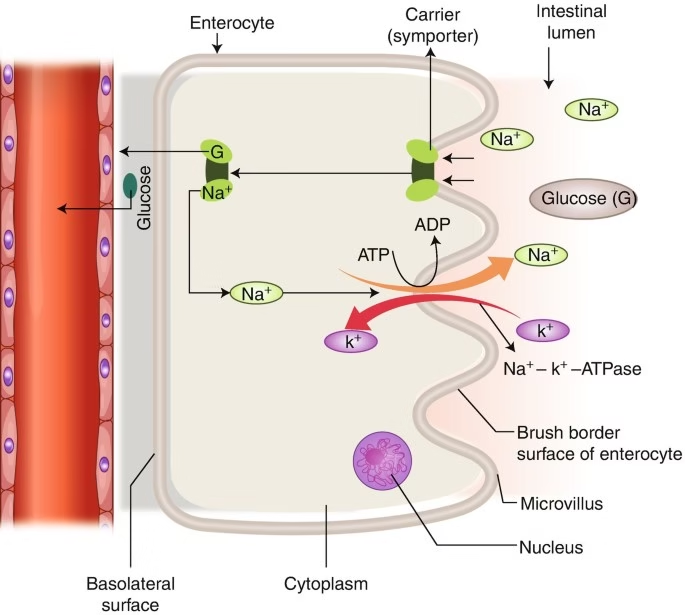
3. Mechanisms of Absorption
Carbohydrate absorption involves three major transporters:
-
SGLT-1 → absorbs glucose and galactose
-
GLUT-5 → absorbs fructose
-
GLUT-2 → transports all monosaccharides into the blood
Each transporter employs a distinct mechanism, ensuring efficient uptake even when concentration gradients fluctuate.
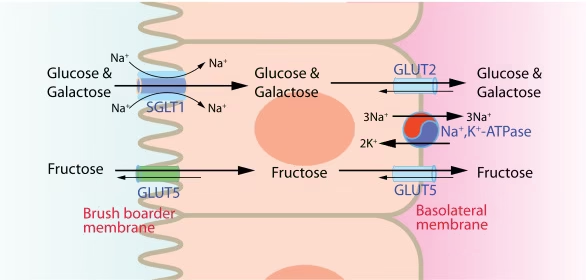
A. Glucose and Galactose Absorption (Active Transport)
Transporter: SGLT-1 (Sodium-Glucose Linked Transporter-1)
Mechanism:
-
Secondary active transport
-
Requires Na⁺ gradient, not direct ATP
-
Na⁺/K⁺ ATPase pump (on basolateral membrane) maintains this gradient
-
Glucose/galactose are co-transported with two sodium ions
Why is this important?
-
Allows absorption even when intestinal glucose concentration is low
-
Explanation for the success of Oral Rehydration Therapy (ORT) — glucose enhances sodium and water absorption
B. Fructose Absorption (Facilitated Diffusion)
Transporter: GLUT-5
Mechanism:
-
Facilitated diffusion, not energy-dependent
-
Works along the concentration gradient
Characteristics:
-
Slower than glucose absorption
-
Overconsumption of fructose can overwhelm GLUT-5 → bloating, diarrhea
C. Transport Into the Bloodstream
After entering the enterocyte:
Transporter: GLUT-2
Function:
-
Moves glucose, galactose, and fructose from the intestinal cell to the portal blood
-
Operates by facilitated diffusion
Pathway:
Enterocyte →
Basolateral membrane →
GLUT-2 →
Portal vein →
Liver →
Metabolic processing
The liver converts fructose and galactose into glucose derivatives for utilization.
Regulation of Carbohydrate Absorption
Carbohydrate absorption is regulated mainly by enzyme activity, transporter function, and intestinal health.
1. Brush-Border Enzyme Levels
- Adequate lactase, sucrase, maltase, and isomaltase are essential.
- Low enzyme activity reduces digestion → poor absorption (e.g., lactose intolerance).
2. Transporter Activity
- SGLT-1 regulates glucose and galactose uptake.
- GLUT-5 regulates fructose uptake.
- GLUT-2 regulates the exit of monosaccharides into the blood.
Their expression increases with high carbohydrate intake.
3. Intestinal Mucosal Health
- Diseases like celiac disease, Crohn’s disease, and infections damage villi → reducing absorption.
4. Hormonal Influence
- Incretins (GLP-1, GIP) and insulin can modulate transporter expression and glucose uptake rate.
5. Luminal Factors
- The presence of sodium enhances glucose absorption (via SGLT-1).
- Adequate pH and proper mixing improve enzyme efficiency.
Clinical Aspects of Carbohydrate Absorption
Clinical issues related to carbohydrate absorption usually arise when digestive enzymes, intestinal transporters, or intestinal mucosa are impaired. These disturbances lead to malabsorption, gastrointestinal symptoms, and metabolic imbalances.
1. Lactose Intolerance (Lactase Deficiency)
The most common clinical disorder of carbohydrate absorption.
Features
- Caused by reduced lactase enzyme activity.
- Unabsorbed lactose draws water into the intestine (osmotic effect).
- Fermentation by colonic bacteria produces gas.
Symptoms
- Bloating
- Flatulence
- Abdominal cramps
- Diarrhea
Biochemical Basis:
-
Reduced lactase enzyme on brush-border → incomplete breakdown of lactose into glucose + galactose
-
Lactose remains unabsorbed (cannot use SGLT-1 or GLUT transporters)
Consequence:
-
Osmotic diarrhea due to unabsorbed lactose
-
Bacterial fermentation → lactic acid, hydrogen gas
-
Symptoms: bloating, cramps, flatulence
2. Fructose Malabsorption
Occurs due to reduced capacity of the GLUT-5 transporter.
Clinical Manifestations
- Bloating
- Diarrhea
- Abdominal pain after consuming high-fructose foods (juices, honey, soft drinks)
Mechanism:
-
Decreased activity or saturation of GLUT-5 transporter
-
Fructose cannot be absorbed by SGLT-1 or GLUT-2 → remains in lumen
Clinical outcome:
-
Bloating, diarrhea, abdominal pain
-
Excessive fructose fermentation by colonic bacteria
3. Sucrase-Isomaltase Deficiency
A rare congenital or acquired defect.
Effects
- Incomplete digestion of sucrose and starch.
- Symptoms resemble those of lactose intolerance but are triggered by foods rich in sucrose.
Biochemical Problem:
-
Deficiency of sucrase–isomaltase complex → impaired hydrolysis of sucrose and α-limit dextrins
Effect:
-
Malabsorption of sucrose and starch breakdown products
-
Leads to osmotic diarrhea and post-meal discomfort
4. Malabsorption Syndromes Affecting Carbohydrates
Damage to the intestinal mucosa reduces enzyme activity and transporter expression.
Common Causes
- Celiac disease
- Tropical sprue
- Crohn’s disease
- Infectious enteritis
- Chemotherapy or radiation-induced injury
Consequences
- Poor absorption of all carbohydrates
- Weight loss
- Nutrient deficiencies
- Chronic diarrhea
Biochemical Impact:
-
Loss of brush-border enzymes
-
Decreased SGLT-1, GLUT-5, and GLUT-2 expression
-
Reduced surface area for absorption
Result:
-
Malabsorption of all carbohydrates
-
Nutrient loss, diarrhea, weight loss
5. Dumping Syndrome
Seen after gastric surgery.
Mechanism
- Rapid entry of hyperosmolar carbohydrates into the small intestine
- Causes massive fluid shifts and hormonal changes
Symptoms
- Nausea
- Dizziness
- Palpitations
- Diarrhea
Mechanism:
-
Rapid delivery of hyperosmolar carbohydrates into small intestine
-
Sudden fluid shifts and exaggerated insulin response
Biochemical Effect:
-
Rapid glucose absorption → high blood glucose → reactive hypoglycemia
6. Diabetes and Carbohydrate Absorption
- Absorption rates are normal, but utilization is impaired due to insulin deficiency/resistance.
- High carbohydrate loads can cause exaggerated post-meal glucose spikes.
7. Oral Rehydration Therapy (ORT)
A major clinical success based on SGLT-1 transporter physiology.
Concept
- Glucose promotes sodium and water absorption → life-saving in diarrhea
- Used globally to prevent dehydration in children and adults
Scientific Basis:
-
SGLT-1 co-transports glucose + sodium, enhancing water absorption
-
Used even when diarrhea impairs other absorption processes
Importance:
-
A life-saving application of carbohydrate transport physiology
8. Small Intestinal Bacterial Overgrowth (SIBO)
Bacteria ferment unabsorbed carbohydrates before they reach the colon.
Effects
- Gas production
- Bloating
- Diarrhea
- Malnutrition in severe cases
